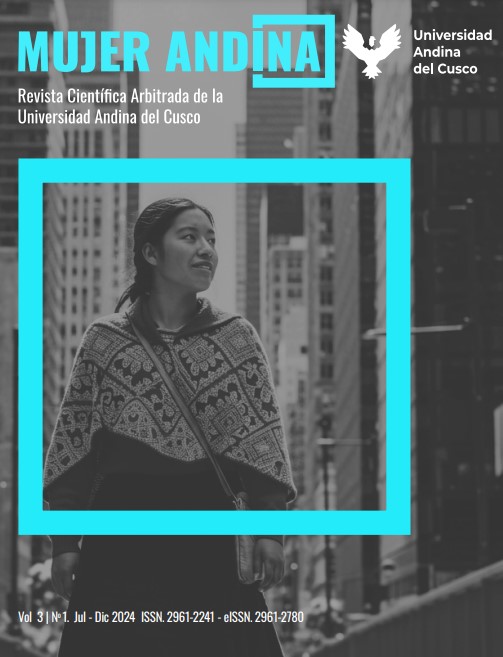Cómo crear una verdadera equidad de género para distinguirla de una falsa equidad de género
DOI:
https://doi.org/10.36881/ma.v3i1.950Palabras clave:
equidad de género, falsa equidad de género, resistencia organizacional, prácticas de género superficiales, cambio cultural patriarcalResumen
La equidad de género ha ganado relevancia en las últimas décadas, particularmente en políticas públicas y en el ámbito empresarial. Sin embargo, con el aumento de la visibilidad del tema también surge la falsa equidad de género, cuando las acciones parecen igualitarias en la superficie pero no abordan las barreras sistémicas que mantienen la desigualdad. Este estudio se centra en identificar las diferencias entre la equidad de género auténtica y las prácticas organizacionales superficiales que aparentan ser equitativas. Utilizando un diseño cualitativo basado en el análisis documental y la técnica de análisis en progreso se observó que, a pesar de los avances en la representación femenina y las reformas estructurales, muchas organizaciones persisten en prácticas superficiales que simulan equidad de género sin implementar cambios culturales reales. Se concluye que, para una verdadera equidad de género, no bastan las políticas inclusivas y las reformas estructurales, sino un cambio cultural que desafíe las normas patriarcales y promueva nuevas masculinidades en el entorno laboral.
Descargas
Citas
Acker, J. (1990). Hierarchies, jobs, bodies: A Theory of Gendered Organizations. Gender & Society, 4(2), 139-158. https://doi.org/10.1177/089124390004002002
Acker, J. (2006). Inequality regimes: Gender, class, and race in organizations. Gender & society, 20(4), 441-464. https://doi.org/10.1177/0891243206289499
Ahmed, S. (2012). On being included: Racism and diversity in institutional life. In On being included. Duke University Press. https://doi.org/10.1515/9780822395324
Ashcraft, K.L. (2009). Gender and Diversity: Other Ways to “Make a Difference”. In M. Alvesson, T. Bridgman & H. Willmott (eds.), The Oxford Handbook of Critical Management Studies. Oxford University Press, 1-25.
Baxter, J. & Wright, E. O. (2000). The glass ceiling hypothesis: A comparative study of the United States, Sweden, and Australia. Gender & society, 14(2), 275-294. https://doi.org/10.1177/089124300014002004
Beasley, C. (2012). Problematizing Contemporary Men/Masculinities Theorizing: The Contribution of Raewyn Connell and Conceptual-Terminological Tensions Today. British Journal of Sociology, 63(4), 747-765. https://doi.org/10.1111/j.1468-4446.2012.01435.x
Bennett, F. (2024). Gendered economic inequalities: a social policy perspective. Oxford Open Economics, 3(Supplement_1), i345-i353. https://doi.org/10.1093/ooec/odad030
Benschop, Y. & Doorewaard, H. (1998). Covered by equality: The gender subtext of organizations. Organization Studies, 19(5), 787-805. https://doi.org/10.1177/017084069801900504
Benschop, Y. (2021). Grand challenges, feminist answers. Organization Theory, 2(3), 26317877211020323. https://doi.org/10.1177/26317877211020323
Berggren, K. (2018). Is Everything Compatible? A Feminist Critique of Hearn’s Composite Approach to Men and Masculinity. Australian Feminist Studies, 33(97), 331-344. https://doi.org/10.1080/08164649.2018.1542590
Catalyst. (2020). Women in leadership: Representation, progress, and the way forward. In Catalyst Research Reports. https://www.catalyst.org
Cecchini, S., Holz, R. & Soto de la Rosa, H. (2021). Caja de herramientas. Promoviendo la igualdad: el aporte de las políticas sociales en América Latina y el Caribe (LC/TS.2021/55). Comisión Económica para América Latina y el Caribe (CEPAL).
Connell, R. W. (2005). Masculinities. Routledge.
Crenshaw, K. W. (1989). Mapping the margins: Intersectionality, identity politics, and violence against women of color. In The public nature of private violence (93-118). Routledge. http://www.jstor.org/stable/1229039?origin=JSTOR-pdf
Cudd, A. E. & Jones, L. E. (2005). Sexism. In R. G. Frey & Christopher Heath Wellman (eds.), A Companion to Applied Ethics. Wiley-Blackwell, 102-117. https://www.wellesu.com/10.1002/9780470996621.ch8
Eagly, A. H., Carli, L. L. & Carli, L. L. (2007). Through the labyrinth: The truth about how women become leaders. Harvard Business School Press. https://doi.org/10.1108/gm.2009.05324aae.001
Ely, R. J. & Meyerson, D. E. (2000). Theories of gender in organizations: A new approach to organizational analysis and change. Research in organizational behavior, 22, 103-151. https://n9.cl/cd8ag
Flood, M. (2015). Men and Gender Equality. In Engaging Men. In Building Gender Equality. Ed. M. Flood, with R. Howson. Cambridge Scholars Press, 1-31. https://n9.cl/hnsuo
Foucault, M. (1980). Power/knowledge: selected interviews and other writings 1972-1977. Colin Gordon.
Fraser, N. (1997). Justice interruptus: Critical reflections on the "postsocialist" condition. Routledge. https://doi.org/10.4324/9781315822174
Fraser, N. (2013). Fortunes of feminism: From state-managed capitalism to neoliberal crisis (256). Verso.
Hartmann, H. I. (1979). The unhappy marriage of Marxism and feminism: Towards a more progressive union. Capital & Class, 3(2), 1-33. https://doi.org/10.1177/03098168790080010
Heilman, M. E. & Caleo, S. (2018). Combatting gender discrimination: A lack of fit framework. Group Processes & Intergroup Relations, 21(5), 725-744. https://doi.org/10.1177/1368430218761587
Hooks, B. (2000). Feminism is for Everybody: Passionate Politics. South End Press.
Ibarra, H., Ely, R. & Kolb, D. (2013). Women rising: The unseen barriers. Harvard Business Review, 91(9), 60-66. https://n9.cl/fe969
Kalev, A., Dobbin, F. & Kelly, E. (2006). Best practices or best guesses? Assessing the efficacy of corporate affirmative action and diversity policies. American sociological review, 71(4), 589-617. http://www.jstor.org/stable/30039011?origin=JSTOR-pdf
Kimmel, M. (2017). Angry white men: American masculinity at the end of an era. Hachette UK.
McKinsey & Company. (2022). Women in the workplace: Barriers and breakthroughs. McKinsey Global Institute. https://n9.cl/d36up2
McKinsey & Company. (2024). Women in the Workplace 2024: The 10th-anniversary report. https://www.mckinsey.com/featured-insights/diversity-and-inclusion/women-in-the-workplace#/
Meyerson, D. E. & Kolb, D. M. (2009). Moving out of the ‘armchair’: Developing a framework to bridge the gap between feminist theory and practice (191-208). VS Verlag für Sozialwissenschaften. https://doi.org/10.1007/978-3-531-91387-2_13
REDMAD. (2023). ¿Es la meritocracia compatible con la igualdad de género? https://goo.su/GLUCwG
Ridgeway, C. L. & Markus, H. R. (2022). The significance of status: what it is and how it shapes inequality. RSF: The Russell Sage Foundation Journal of the Social Sciences, 8(7), 1-25. https://doi.org/10.7758/RSF.2022.8.7.01
Storvik, A. & Teigen, M. (2010). Women on Board: The Norwegian Experience. Friedrich Ebert Stiftung. https://library.fes.de/pdf-files/id/ipa/07309.pdf
Taylor, S.J. & Bogdan, R. (1987). Introducción a los métodos cualitativos de investigación: la búsqueda de significados. Ediciones Paidós Ibérica, S.A.
UN Women. (2010). Gender equality. Womens’s Rights in Review, 25, 1-4. https://n9.cl/hyxrv3
Walby, S., Armstrong, J. & Strid, S. (2012). Intersectionality: Multiple inequalities in social theory. Sociology, 46(2), 224-240. https://doi.org/10.1177/0038038511416164
Williams, C. L., Kilanski, K. & Muller, C. (2014). Corporate diversity programs and gender inequality in the oil and gas industry. Work and Occupations, 41(4), 440-476. https://doi.org/10.1177%2F0730888414539172
World Economic Forum. (2023). Global Gender Gap Report 2023. World Economic Forum.
Descargas
Publicado
Cómo citar
Número
Sección
Categorías
Licencia

Esta obra está bajo una licencia internacional Creative Commons Atribución 4.0.
El contenido de las publicaciones es responsabilidad de los autores. La revista permite a los autores mantener los derechos de autor sobre los artículos y documentos publicados. La licencia usada es Commons Reconocimiento -No Comercial Internacional License. CC BY

















